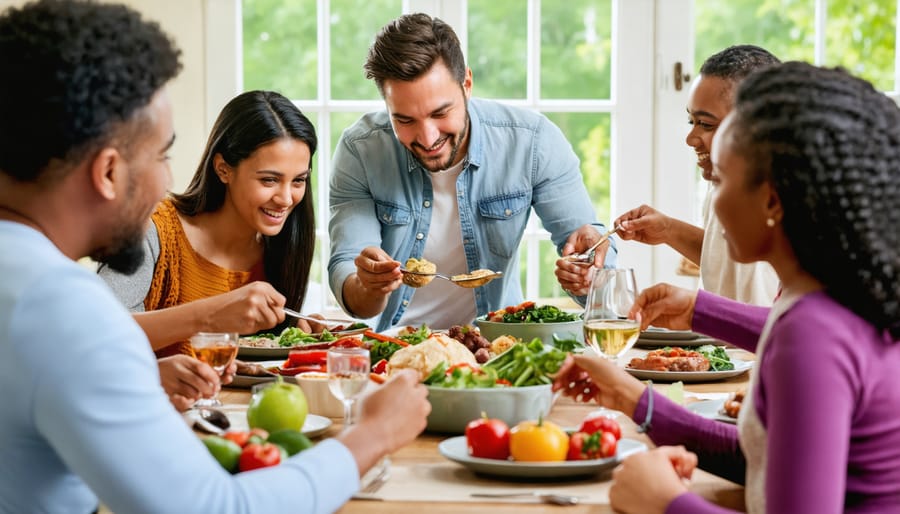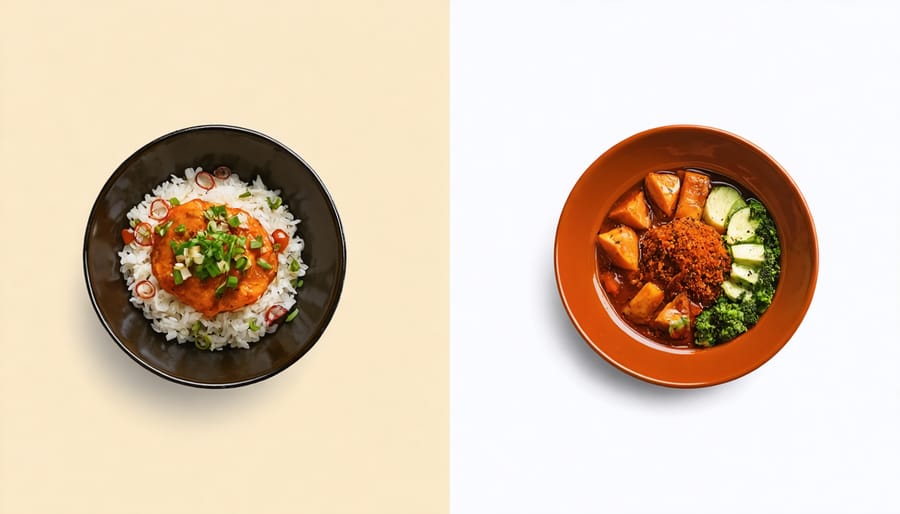
Picture this: you’re seated at a bustling dinner table in Tokyo, wondering whether to stick your chopsticks upright in your rice bowl. That split-second cultural decision could make or break the evening. Navigating cultural differences isn’t just about avoiding faux pas – it’s an art that enriches our lives and deepens our connections across borders, both literal and metaphorical.
In today’s interconnected world, cultural intelligence has become as essential as emotional intelligence. Whether you’re building international business relationships, falling in love across cultural lines, or simply trying to be a more informed global citizen, understanding how to bridge cultural gaps with grace and authenticity can transform challenging moments into opportunities for growth and connection.
The beauty of cultural differences lies not in erasing them but in embracing them as windows into new ways of seeing, thinking, and being. Like learning to dance with a new partner, it requires patience, curiosity, and a willingness to sometimes step on toes – figuratively speaking. As someone who’s navigated cross-cultural relationships both professionally and personally, I’ve discovered that the most meaningful connections often emerge from those moments when we dare to step outside our cultural comfort zones.
This guide will help you develop the skills to move confidently across cultural landscapes while maintaining respect, authenticity, and open-mindedness.
Communication Styles Across Cultures

Direct vs. Indirect Communication
I remember my first business meeting in Japan, where my direct American approach of “getting straight to the point” was met with polite smiles but subtle discomfort. This experience taught me a valuable lesson about the intricate dance between direct and indirect communication styles across cultures.
In some cultures, like those in North America and Northern Europe, people typically value direct communication – saying exactly what they mean without beating around the bush. On the flip side, many Asian and Middle Eastern cultures often prefer indirect communication, where messages are conveyed through context, subtle hints, and non-verbal cues.
Understanding these differences and implementing effective communication strategies can make or break cross-cultural relationships. For instance, while a direct communicator might say, “I disagree with this proposal,” an indirect communicator might say, “That’s an interesting perspective. Perhaps we could also consider…”
Neither style is inherently better – they’re simply different approaches that have evolved within various cultural contexts. The key is developing awareness and flexibility. When interacting with someone from a different communication style, try to:
– Observe and mirror their communication pattern
– Ask clarifying questions when unsure
– Be patient with different approaches
– Practice active listening
– Show respect for both styles
Remember, adapting your communication style isn’t about changing who you are; it’s about building bridges and fostering deeper understanding across cultures.
Non-verbal Communication Differences
I’ll never forget the moment I reached out to shake hands with my Japanese colleague, only to be met with a graceful bow – a perfect example of how non-verbal communication can vary dramatically across cultures! These silent signals often speak louder than words, and understanding them is crucial for building meaningful cross-cultural relationships.
Personal space is another fascinating aspect that differs worldwide. While Americans typically maintain an arm’s length distance in conversations, many Mediterranean and Middle Eastern cultures prefer closer proximity. I’ve learned that what feels uncomfortably close to some might be perfectly natural to others.
When it comes to gestures, what’s perfectly innocent in one culture could be offensive in another. The thumbs-up sign, while positive in many Western countries, can be considered rude in some Middle Eastern nations. Even nodding your head doesn’t universally mean “yes” – in Bulgaria, it actually means “no”!
Eye contact also carries different meanings across cultures. While direct eye contact is often expected in Western business settings, it might be considered disrespectful in many Asian and African cultures. I’ve found that observing locals and being mindful of these differences helps navigate these subtle yet important aspects of communication.
Remember, there’s no universal rulebook for body language. The key is remaining open-minded, observant, and willing to adapt your non-verbal communication style when needed. When in doubt, it’s always better to ask respectfully about local customs than to make assumptions.
Family Dynamics and Expectations

Meeting the Family
Meeting your partner’s family for the first time can feel like navigating uncharted waters, especially when cultural traditions come into play. I remember the first time I met my husband’s family – I wasn’t sure whether to bow, shake hands, or go in for a hug! The key is to do your homework beforehand and communicate openly with your partner about expectations.
Start by asking your partner about specific customs or protocols their family follows. In some cultures, bringing a gift is essential, while in others, it might be seen as unnecessary. Learn about appropriate dress codes, as what’s considered respectful can vary dramatically between cultures. For instance, some families may expect more conservative attire, while others are quite casual.
Pay attention to forms of address – some cultures use formal titles for elders, while others prefer first names. When in doubt, err on the side of formality until told otherwise. Be mindful of physical boundaries too; while some families are very affectionate, others maintain more personal space.
Meal times often reveal the most significant cultural differences. Follow your host’s lead on when to start eating, how to use utensils, and whether it’s polite to finish everything on your plate. Show appreciation for any food offered, even if it’s unfamiliar – it’s often a way families express love and welcome.
Remember, most families appreciate genuine interest and respect for their traditions, even if you make minor mistakes along the way. Your willingness to learn and adapt speaks volumes about your commitment to understanding their culture.
Balancing Family Traditions
When it comes to blending different cultural traditions within a family, think of it as creating a beautiful tapestry where each thread represents a unique custom or celebration. I remember attending a wedding where the couple masterfully wove together Chinese tea ceremonies with Western wedding traditions, creating an experience that honored both families while establishing their own unique celebration.
The key to successfully balancing family traditions lies in open communication and mutual respect. Start by having honest conversations with your partner about which traditions hold special meaning for each of you. Consider creating a family calendar that marks important cultural celebrations from both sides, ensuring neither gets overlooked.
One approach that works well for many families is the “both/and” rather than “either/or” mindset. Instead of choosing between celebrating Diwali or Christmas, for example, embrace both festivities. This not only enriches your family’s cultural experience but also helps children develop a deeper appreciation for their diverse heritage.
Be creative in finding ways to blend traditions. Perhaps you can incorporate traditional recipes from both cultures into holiday meals or create new family rituals that combine elements from different backgrounds. Remember that it’s okay to adapt traditions to fit your modern family’s needs while maintaining their core meaning.
Most importantly, approach differences with curiosity and flexibility. What might seem unusual at first often becomes a cherished part of your family’s unique identity. By embracing both sets of traditions, you’re not just preserving cultural heritage – you’re creating a richer, more inclusive family narrative for future generations.
Celebrating Differences
Creating New Traditions
One of the most beautiful aspects of cross-cultural relationships is the opportunity to create something entirely new together. While honoring existing traditions is important, blending different cultural practices can lead to meaningful personal growth through relationships and the emergence of unique customs that represent both partners’ heritage.
Consider Sarah and Akiko, who combined their American and Japanese wedding traditions by having both a traditional Shinto ceremony and a Western reception. They now celebrate major holidays from both cultures, creating a rich tapestry of experiences for their children.
Start small by identifying celebrations or daily rituals that matter most to each partner. Maybe you’ll discover that combining your partner’s Lunar New Year traditions with your family’s Christmas celebrations creates a magical winter season that’s uniquely yours. Or perhaps you’ll develop new cooking traditions that fusion both cultures’ favorite dishes.
The key is to approach this creative process with openness and joy. Don’t feel pressured to maintain every tradition from both backgrounds – instead, choose the ones that resonate most with your shared values and lifestyle. Document these new traditions through photos or journals, allowing them to evolve naturally over time. Remember, these unique customs you create together will become treasured memories and potentially lasting legacies for future generations.
Learning Through Food
Food has an incredible way of bringing people together, transcending language barriers and creating lasting connections. I learned this firsthand when my mother-in-law, who speaks very little English, taught me how to make her famous dumplings. Despite our communication challenges, the process of cooking together became our shared language.
Exploring another culture through its cuisine offers a delicious and approachable entry point to deeper understanding. Start by asking about family recipes and their significance – you’ll often discover that food traditions carry stories of heritage, celebration, and love. When someone shares their traditional dishes with you, they’re often sharing pieces of their identity and history.
Consider hosting a cultural potluck where everyone brings a meaningful dish from their background. As you taste each offering, encourage participants to share the story behind their choice. These gatherings create natural opportunities for cultural exchange and learning in a relaxed, enjoyable setting.
Remember that food preferences and traditions can vary significantly between cultures. What’s considered a delicacy in one culture might be unfamiliar in another. Approach these differences with curiosity rather than judgment. Ask questions about ingredients, preparation methods, and the occasions when certain dishes are served.
By embracing culinary traditions different from our own, we develop not just a broader palate, but also greater cultural empathy and understanding. It’s amazing how sharing a meal can transform strangers into friends and bridge even the widest cultural gaps.

Practical Tips for Success
Open Dialogue
One of the most powerful tools in navigating cultural differences is creating a space for honest, open dialogue. I learned this firsthand when planning my intercultural wedding – what seemed like simple decisions often revealed deeper cultural expectations that needed thoughtful discussion.
Remember, it’s perfectly normal to feel uncomfortable or uncertain when addressing cultural differences. The key is approaching these conversations with curiosity and respect rather than judgment. Start by sharing your own experiences and asking questions about your partner’s perspective. Sometimes, simply saying “I’d love to understand more about why this tradition is important to you” can open up meaningful discussions.
Make a habit of regular check-ins about cultural matters, just as you would for maintaining strong connections in other aspects of your relationship. These conversations might include discussing holiday celebrations, family expectations, or even daily habits that stem from cultural differences.
Remember that misunderstandings are natural and can actually become opportunities for deeper connection. Share your feelings openly, listen actively, and be willing to find creative compromises that honor both cultures. This ongoing dialogue helps build a stronger, more understanding relationship.
Cultural Education
One of the most enriching aspects of cross-cultural relationships is the opportunity to learn about each other’s backgrounds. I remember how fascinated I was when my friend Maria first taught me about her family’s Day of the Dead celebrations – it opened up a whole new perspective on how different cultures honor their loved ones.
Start by showing genuine curiosity about your partner’s or friend’s traditions. Ask thoughtful questions about their holidays, customs, and family practices. Share stories about your own upbringing and cultural experiences, creating a two-way exchange that builds understanding and appreciation.
Consider creating special occasions where you can experience each other’s cultures firsthand. Cook traditional meals together, attend cultural festivals, or participate in holiday celebrations. These shared experiences not only deepen your knowledge but also create lasting memories and strengthen your bond.
Remember that cultural education is an ongoing journey. What might seem unusual at first often becomes meaningful once you understand the context and significance behind it. Be patient with yourself and others as you learn, and approach new cultural experiences with an open mind and heart. The more you embrace these learning opportunities, the richer and more rewarding your relationships will become.
Embracing cultural differences in relationships isn’t just about overcoming challenges – it’s about enriching our lives with new perspectives, traditions, and ways of seeing the world. Through my own journey and conversations with countless couples, I’ve discovered that cross-cultural relationships offer unique opportunities for personal growth and deep, meaningful connections.
Remember that patience, open communication, and genuine curiosity are your greatest allies. When we approach cultural differences with respect and understanding, they transform from potential obstacles into bridges that strengthen our bonds. Take time to celebrate both your similarities and differences, creating new traditions that honor both backgrounds while building something uniquely yours.
The key is maintaining a balance between preserving individual cultural identities and creating shared experiences. Whether it’s learning each other’s languages, participating in traditional celebrations, or blending family customs, these moments become the foundation of your shared story.
Most importantly, recognize that navigating cultural differences is an ongoing journey, not a destination. Every challenge overcome and every tradition shared adds another layer to your relationship’s tapestry. By remaining open-minded, flexible, and committed to understanding each other, you’ll find that cultural differences aren’t barriers to love – they’re catalysts for creating a richer, more vibrant life together.



